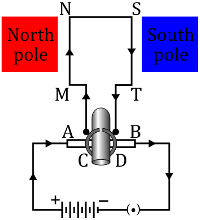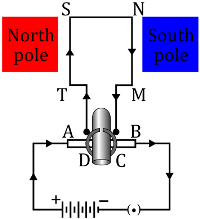Question 11:
Draw a labelled diagram of an electric motor. Explain its principle and working.
What is the function of a split ring in an electric motor?
Answer:
An electric motor converts electrical energy into mechanical energy.
It works on the principle of the magnetic effect of current. A current-carrying coil
rotates in a magnetic field. The following figure shows a simple electric motor.

When a current is allowed to flow through the coil MNST by closing the switch,
the coil starts rotating anti-clockwise. This happens because a downward force
acts on length MN and at the same time, an upward force acts on length ST.
As a result, the coil rotates anti-clockwise.
Current in the length MN flows from M to N and the magnetic field acts from left
to right, normal to length MN. Therefore, according to Fleming’s left hand rule, a
downward force acts on the length MN. Similarly, current in the length ST flows
from S to T and the magnetic field acts from left to right, normal to the flow of
current. Therefore, an upward force acts on the length ST. These two forces cause
the coil to rotate anti-clockwise.
After half a rotation, the position of MN and ST interchange. The half-ring D comes
in contact with brush A and half-ring C comes in contact with brush B. Hence, the
direction of current in the coil MNST gets reversed.

The current flows through the coil in the direction TSNM. The reversal of current
through the coil MNST repeats after each half rotation. As a result, the coil rotates
unidirectional.
The split rings help to reverse the direction of current in the circuit. These are
called the commutator.

